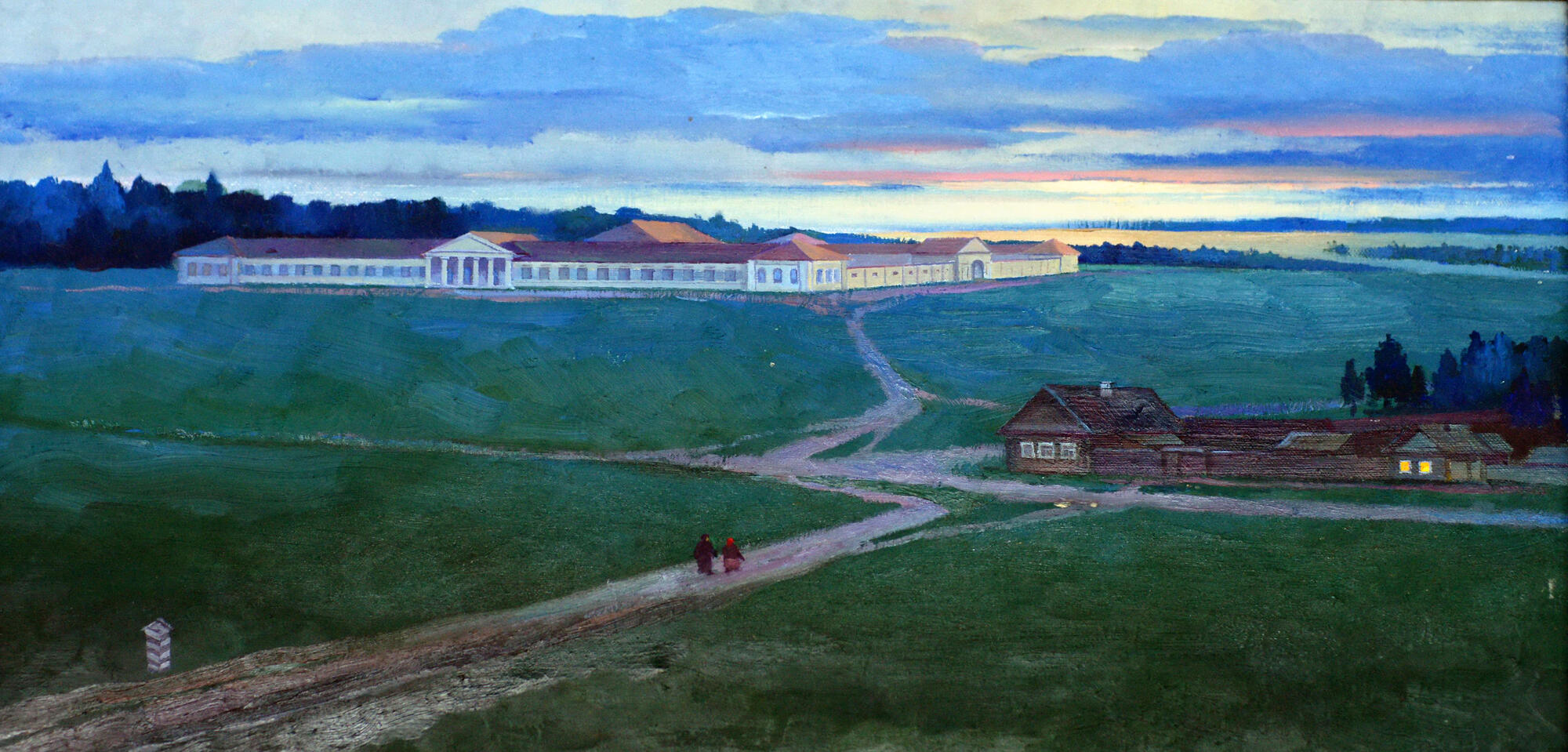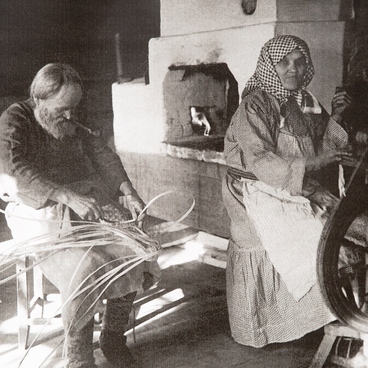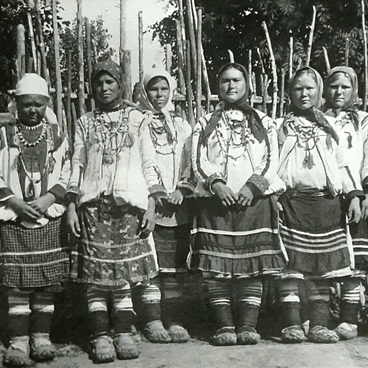In the foreground of the painting Old Izhevsk (the Arsenal), we see an empty area, a dirt road, and a milestone. On the right are the wooden houses of Vosmaya Street (literally: 8th Street)—currently Pushkinskaya Street—which is the central street of Izhevsk. In the background, there is a single-story stone building with columns: it is the Arsenal which stored the weapons of the Izhevsk Arms Plant.
The painting was painted by artist Alexei Rychkov in 1987; Rychkov created this painting as a sketch for his graduation project. To create it, the artist used a copy of a photo postcard from the early 20th century with a view of the Izhevsk Arsenal. The photographs for a set of postcards with views of Izhevsk were taken by Izhevsk photographer Dmitry Naimushin in 1912. Alexey Rychkov’s thesis painting is stored in Xining, China — it is the sister city of Izhevsk.
The project of the Arsenal was conceived and brought to life by the first architect of the Izhevsk plant, Semyon Dudin. The architect graduated with a gold medal from the Academy of Arts in St. Petersburg in 1798. The arsenal was designed to store 60–100 thousand guns; its construction began in 1823. Dudin, a talented architect and urban planner, designed the arsenal to accommodate the growing size of the city. The architect placed the Arsenal on the most elevated place in a vast field so that the architecture of the Arsenal would decorate the city when it eventually encompasses the Arsenal.
The design of all three facades of the building is informed by the strict traditions of Russian classicism. The strict “square” is enclosed by a southern wall with embrasures and a guard tent. The Arsenal design received high praise from Emperor Alexander I when he visited the Izhevsk plant in 1824. The Emperor awarded the architect with the Order of Vladimir, 4th degree. The construction was completed in October of 1825.
For many decades, weapons produced by Izhevsk workers were stored in the Arsenal building. When these arms were needed, they were packed in special boxes and sent to military units. One of the chambers in the Arsenal was a museum of sorts: samples of all types of weapons manufactured by the plant were collected. During the First World War, stock workshop was transferred from the main territory of the plant to the Arsenal building — this move was necessitated by the expansion of main production facilities.
At present, the building of the Arsenal houses the National Museum of the Udmurt Republic Named After Kuzebay Gerd. The building is a federally recognized architectural monument.
The painting was painted by artist Alexei Rychkov in 1987; Rychkov created this painting as a sketch for his graduation project. To create it, the artist used a copy of a photo postcard from the early 20th century with a view of the Izhevsk Arsenal. The photographs for a set of postcards with views of Izhevsk were taken by Izhevsk photographer Dmitry Naimushin in 1912. Alexey Rychkov’s thesis painting is stored in Xining, China — it is the sister city of Izhevsk.
The project of the Arsenal was conceived and brought to life by the first architect of the Izhevsk plant, Semyon Dudin. The architect graduated with a gold medal from the Academy of Arts in St. Petersburg in 1798. The arsenal was designed to store 60–100 thousand guns; its construction began in 1823. Dudin, a talented architect and urban planner, designed the arsenal to accommodate the growing size of the city. The architect placed the Arsenal on the most elevated place in a vast field so that the architecture of the Arsenal would decorate the city when it eventually encompasses the Arsenal.
The design of all three facades of the building is informed by the strict traditions of Russian classicism. The strict “square” is enclosed by a southern wall with embrasures and a guard tent. The Arsenal design received high praise from Emperor Alexander I when he visited the Izhevsk plant in 1824. The Emperor awarded the architect with the Order of Vladimir, 4th degree. The construction was completed in October of 1825.
For many decades, weapons produced by Izhevsk workers were stored in the Arsenal building. When these arms were needed, they were packed in special boxes and sent to military units. One of the chambers in the Arsenal was a museum of sorts: samples of all types of weapons manufactured by the plant were collected. During the First World War, stock workshop was transferred from the main territory of the plant to the Arsenal building — this move was necessitated by the expansion of main production facilities.
At present, the building of the Arsenal houses the National Museum of the Udmurt Republic Named After Kuzebay Gerd. The building is a federally recognized architectural monument.



